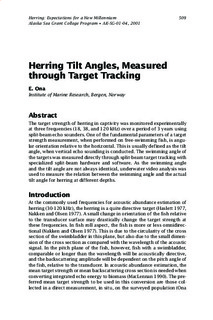| dc.contributor.author | Ona, Egil | |
| dc.date.accessioned | 2008-04-07T11:56:41Z | |
| dc.date.issued | 2001 | |
| dc.identifier.isbn | 1-56612-070-5 | |
| dc.identifier.uri | http://hdl.handle.net/11250/108201 | |
| dc.description | International Herring Symposium (2000 : Anchorage, Alaska)
Herring : expectations for a new millenium : proceedings of the symposium Herring 2000, expectations for a new millenium, Anchorage, Alaska, USA, Febrary 23-26, 2000 / editors Fritz Funk ...[et al.]. - Fairbanks :
University of Alaska, 2001. - X, 789 s. : ill. (Lowell Wakefield Fisheries Symposium ; 18th). - (Report / Alaska Sea Grant College Program ; 01-04) | en |
| dc.description.abstract | The target strength of herring in captivity was monitored experimentally at three frequencies (18, 38, and 120 kHz) over a period of 3 years using split-beam echo sounders. One of the fundamental parameters of a target strength measurement, when performed on free-swimming fish, is angular orientation relative to the horizontal. This is usually defined as the tilt angle, when vertical echo sounding is conducted. The swimming angle of the targets was measured directly through split-beam target tracking with specialized split-beam hardware and software. As the swimming angle and the tilt angle are not always identical, underwater video analysis was used to measure the relation between the swimming angle and the actual tilt angle for herring at different depths. | en |
| dc.format.extent | 110939 bytes | |
| dc.format.mimetype | application/pdf | |
| dc.language.iso | nob | en |
| dc.publisher | Alaska Sea Grant College Program | en |
| dc.relation.ispartofseries | Report / Alaska Sea Grant College Program | en |
| dc.relation.ispartofseries | 01-04 | en |
| dc.subject | echo sounder | en |
| dc.subject | ekkolodd | |
| dc.subject | sonar | |
| dc.title | Herring tilt angles, measured through target tracking | en |
| dc.type | Chapter | en |
| dc.subject.nsi | VDP::Agriculture and fishery disciplines: 900::Fisheries science: 920::Resource biology: 921 | en |
| dc.source.pagenumber | 509-519 | en |
